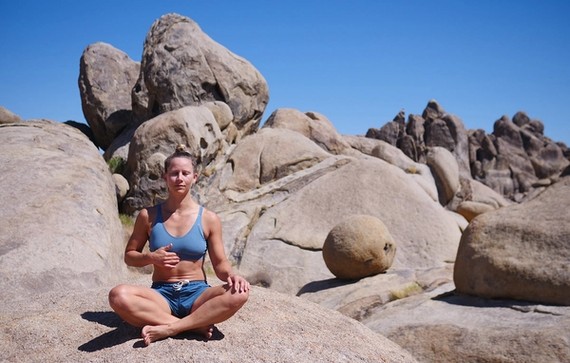Mental Fortitude

The emotional rollercoaster of the professional athlete’s life requires serious mental fortitude — which is why training programs focus as much on the mind as they do on the body.
As an athlete, I have been blessed to learn about the body and mind from some of the best trainers and coaches in the world.
However, her interest wasn’t limited to winning competitions. The more she learned, the more fascinated she became with connecting the body and the mind. “While training with these amazing experts, I made sure to pay close attention to everything they said and ask them a ton of questions so that I could better understand the way we, humans, work,” Kjersti explains and adds, “and yes, I guess you can kind of call me a nerd when it comes this.”
Kjersti continued researching the field of body-mind connection on her own, reaching out to experts outside her core team and completing a Bachelor’s degree in Sports Science. In addition to that, she immersed herself in conscious breathwork and finished a 200-hour certification as a meditation teacher. Now Kjersti uses her vast knowledge along with her mental training as an Olympian to help people in all areas of life, not just in sports.
“I still work with Olympic athletes, but also CEOs of small and large businesses, entire companies, and even individuals and groups who wish to join our PRSNT retreats,” says Kjersti. She believes that everyone can benefit from mental training, just as much as athletes. That’s why her team hosts events like PRSNT all over the world which seek to empower women through outdoor adventures and activities like surfing, outdoor climbing, backcountry snowboarding and skiing, all combined with yoga, meditation, and a #PRSNT state of mind.
“Throughout my sports career, I learned an incredible amount about overcoming pressure and stress, and what it means to train my mind ‘to be on my side’ — to work with me, instead of against me. But mental training like this shouldn’t be reserved for athletes. We live in a challenging time where many people feel daily stress, anxiety, and restlessness. With everything happening in the world these days, it’s not easy to find calmness, peace, and feel grounded.”
Kjersti says her true passion is to share the art and practice of meditation and ‘presentness’ in a lighthearted, fun, and digestible way. “I believe that we are much more likely to be successful when we are enjoying the game of life, in a free and liberating way.”
That’s why Kjersti wants to help people to discover that anyone can meditate — and that a little goes a long way. You don’t need to be in intensive athletic training camps to improve your mental state by connecting more with your body. This is something we can all achieve in our everyday lives through small thoughtful actions. So let’s hear directly from Kjersti herself where you should start:
Read more7 ways to train your mind like an Olympian

Many people exercise physically — which is great! — but I often find mental aspects are forgotten or under-prioritised in the process. The truth is, mental training is just as valuable and important. And it does not have to be complicated at all. It can be as natural, versatile, and playful as physical training.
I like to look at mental training like pull-ups for the brain, squats for the nervous system, surfing, summit hikes, and snowboarding for our body and soul. So with that in mind, here are the seven ways you can start your mental fitness journey.
1. Understand your relationship with oxygen
Oxygen isn’t only essential for life to exist, it’s what makes it thrive. Oxygen-rich soil is more fruitful and creates a healthy and diverse environment for microorganisms and bacteria to grow and thrive. Even sourdough bread tastes better and is fuller of life the more air you get into it! And the same goes for us humans.
Breathing doesn’t just allow us to exist, it can also enhance us and make us fuller of life. That’s why we must learn to breathe better to be healthy, overcome challenges, and thrive.
2. Extend your exhales
The first step to genuinely thriving — whether you’re preparing for the Olympics or simply improving your daily life — is balancing your inhaling and exhaling. In my work, I often find people’s default breathing short and shallow, which in most cases will make them feel stressed and overwhelmed. A quick way to rebalance your breathing is to focus on extending your exhales and practice making them twice the length of your inhales. Just think of how you exhale when you truly feel relief in your body and mind: Ahhhhhh! You let all the air out.
Once you’ve adopted deeper breaths and longer exhales, you’ll feel calmer and less stressed. The reason for this is that every exhale triggers our nervous system to relax. Every inhalation, however, triggers the opposite by activating and stimulating us. So you can use these triggers mindfully to alter your state of mind — and I’ve used this countless times as an athlete to overcome nerves before a big competition.
3. Check in with your body
Many think of stress as a purely mental thing, but often it can have physical manifestations in the body, causing us to feel uneasy, resistant, and maybe even anxious. Our stress response is located at the top of the spine which can tighten from computer work, using our phone, or simply from bad posture. A tight jaw, stiff neck, and sore shoulders are some of the characteristics that can trigger a stress response.
Just try it out. How are your shoulders positioned as you read this article? What about your jaw?
The simplest way to fix this is to check in with your body, and you can do this pretty much anywhere at any time. Make a habit of adjusting your posture throughout the day, allowing yourself to relax your jaw and shoulders. This simple awareness will help your body and your nervous system to relax more — which your mind will be thankful for.
4. Change how you view meditation
Meditation does not have to be performed with closed eyes while sitting in the lotus position alone in a dark room like a Buddhist monk. I live an active lifestyle and exercise is essential for everyone to maintain good overall health. Movement of course has the traditional benefits of increasing the body’s endurance, strength, and flexibility — but it’s also a tool to alter your state of mind.
Meditation can and should be integrated into movement and activities you like to do and it can be FUN. I believe that we are much more likely to be successful when we are enjoying the game of life in a free and liberating way. That is why I make sure that everything I do always has a touch of playfulness, including practising and teaching meditation and mindfulness.
5. Meditate with movement
I use movement to ignite the process of changing my mindset from negative to positive. I move my body, run, dance, climb, do yoga, surf, and snowboard for the simple fun of it, and to stay fit and healthy, but also to level up my energy to the frequency which unlocks the things I want to achieve in my life.
I find that meditation and conscious breathing techniques can be quite easily incorporated into physical activity and allows you to enjoy the best of both worlds. The body-mind connection strengthens when we manage to bring the meditative state into activities and movement. I like thinking of it as creating a bridge between the physical and the mental, the two essential pillars of our wellbeing.
6. Focus on breathing during the day
Rebalancing your inhaling and exhaling isn’t the only way to use your breathing to improve your life. Just shifting your attention to how you’re breathing for a few moments can work wonders. You can do this while sitting still, brushing your teeth, biking to a meeting, in the middle of a conversation, or during your favourite exercise. You can also solely breathe in and out of the nose to up the ante.
Nose-breathing acts like a switch for the nervous system and can shift your stress response to relaxation. When the body is in action, blood pumping and pulse increasing, our minds can become calmer. We gain more clarity and power to be mentally strong and enduring in the movement.
7. Use your body to feel present
If you feel like breathing alone doesn’t quite work for you, I recommend adding other senses like touch to ground yourself in the moment. Try gently pressing your thumb and index finger together and feel the sensation on your skin. You can go through all five fingers and hold your attention for 10 seconds on each finger, using both hands. Your mind will have no other choice than to become present because the body is the most concrete representation of the ‘here and now.’
So, use your body as a vehicle to become present, to focus, to be where your feet are. You can for example do this sitting on the sofa at home, before an important meeting, or while going for a nature walk. From there you can work yourself up to a technique called ‘mindful movement’ which is great for focusing the meditation when your mind starts to drift and wander.
Going deeper

Despite having spent years learning everything there is to learn about mental and physical training, Kjersti stays humble and eager to improve.“I am far from done with my journey of understanding the body and mind. In fact, I feel like I am only at the beginning of this exciting adventure.”
Kjersti seeks to deepen her understanding and gain more perspective daily. She feels it’s important to keep up to date on the newest scientific developments regarding the body, brain, and nervous system. And throughout all of this, she makes sure to stay curious about playful ways we can optimise our own bodies and mind.
“I do this not only for myself but to be the best I can be for the world. To brighten my inner light and brighten the world. When we say yes to the #PRSNT moment we also say yes to the unlimited potential to feel life to the fullest.”